Canon T5 vs SL1
The Canon EOS Rebel T5 (called Canon 1200D in some regions) and the Canon EOS Rebel SL1 (labelled Canon 100D in some countries) are two digital cameras that were announced, respectively, in February 2014 and March 2013. Both are DSLR (Digital Single Lens Reflex) cameras that are equipped with an APS-C sensor. Both cameras offer a resolution of 17.9 megapixels.
As their names suggest, both the Canon EOS Rebel T5 and the Canon EOS Rebel SL1 belong to Canon's Rebel line of DSLR cameras. This range of APS-C cameras, which started out with the Canon EOS Digital Rebel in 2003, has been a big commercial success and the backbone of Canon's dominance in the digital camera market. The popularity of the Rebel cameras is the result of them inheriting much of the sensor and shooting technology from earlier released professional DSLRs, while being sold at a much more budget-friendly price point. The strong brand reputation of Canon and the comprehensive EOS system of compatible lenses and accessories further contributes to the appeal of the Rebel cams, including the Canon T5 and Canon SL1. Below is an overview of the main specs of the two cameras as a starting point for the comparison.

Check T5 offers at
ebay.com

Check SL1 offers at
ebay.com
Going beyond this snapshot of core features and characteristics, what are the differences between the Canon EOS Rebel T5 and the Canon EOS Rebel SL1? Which one should you buy? Read on to find out how these two cameras compare with respect to their body size, their imaging sensors, their shooting features, their input-output connections, and their reception by expert reviewers.
Body comparison
The physical size and weight of the Canon T5 and the Canon SL1 are illustrated in the side-by-side display below. The two cameras are presented according to their relative size. Three consecutive views from the front, the top, and the rear side are shown. All size dimensions are rounded to the nearest millimeter.
The SL1 can be obtained in two different colors (black, white), while the T5 is only available in black.
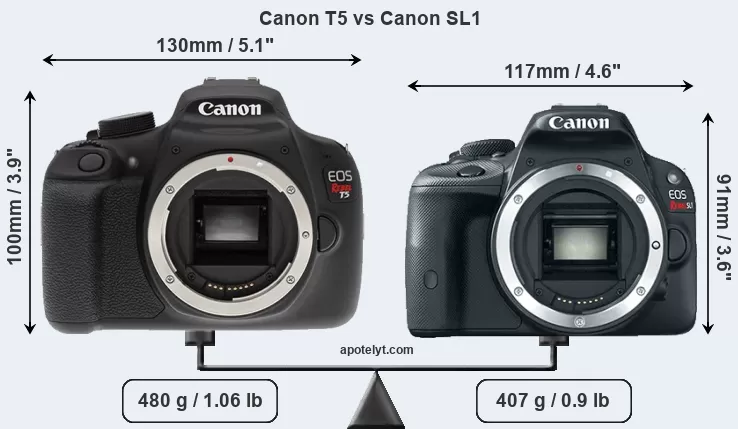
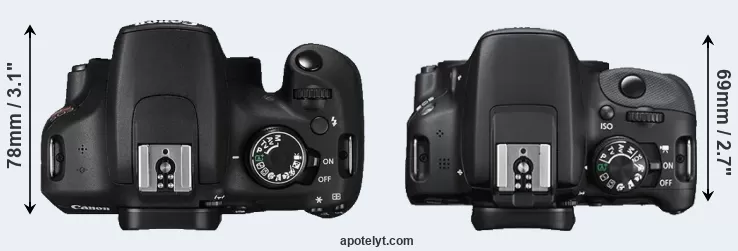
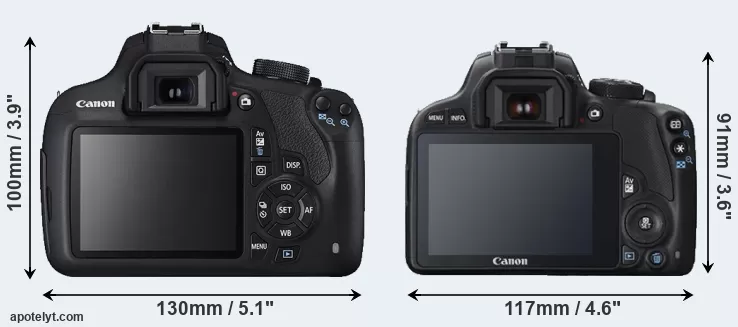
If the front view area (width x height) of the cameras is taken as an aggregate measure of their size, the Canon SL1 is notably smaller (18 percent) than the Canon T5. Moreover, the SL1 is markedly lighter (15 percent) than the T5. In this context, it is worth noting that neither the T5 nor the SL1 are weather-sealed.
The above size and weight comparisons are to some extent incomplete since they do not consider the interchangeable lenses that both of these cameras require. In this particular case, both cameras feature the same lens mount, so that they can use the same lenses. You can compare the optics available in the Canon EF Lens Catalog.
Concerning battery life, the T5 gets 500 shots out of its Canon LP-E10 battery, while the SL1 can take 380 images on a single charge of its Canon LP-E12 power pack.
The following table provides a synthesis of the main physical specifications of the two cameras and other similar ones. If you would like to visualize and compare a different camera combination, you can navigate to the CAM-parator app and make your selection from a broad list of cameras there.

| Camera Model |
Camera Width |
Camera Height |
Camera Depth |
Camera Weight |
Battery Life |
Weather Sealing |
Camera Launch |
Launch Price (USD) |
Street Price |
||
|---|---|---|---|---|---|---|---|---|---|---|---|
| 1. | Canon T5 | 130 mm | 100 mm | 78 mm | 480 g | 500 | n | Feb 2014 | 449 | ebay.com | |
| 2. | Canon SL1 | 117 mm | 91 mm | 69 mm | 407 g | 380 | n | Mar 2013 | 549 | ebay.com | |
| 3. | Canon M | 109 mm | 66 mm | 32 mm | 298 g | 230 | n | Jul 2012 | 599 | ebay.com | |
| 4. | Canon SL2 | 122 mm | 93 mm | 70 mm | 453 g | 650 | n | Jun 2017 | 549 | ebay.com | |
| 5. | Canon T2i | 129 mm | 98 mm | 62 mm | 530 g | 440 | n | Feb 2010 | 699 | ebay.com | |
| 6. | Canon T3 | 130 mm | 100 mm | 78 mm | 495 g | 700 | n | Feb 2011 | 449 | ebay.com | |
| 7. | Canon T3i | 133 mm | 100 mm | 80 mm | 570 g | 440 | n | Feb 2011 | 599 | ebay.com | |
| 8. | Canon T4i | 133 mm | 100 mm | 79 mm | 575 g | 440 | n | Jun 2012 | 849 | ebay.com | |
| 9. | Canon T5i | 133 mm | 100 mm | 79 mm | 580 g | 440 | n | Mar 2013 | 649 | ebay.com | |
| 10. | Canon T6 | 129 mm | 101 mm | 78 mm | 485 g | 500 | n | Mar 2016 | 449 | ebay.com | |
| 11. | Canon T6i | 132 mm | 101 mm | 78 mm | 555 g | 440 | n | Feb 2015 | 749 | ebay.com | |
| 12. | Canon T6s | 132 mm | 101 mm | 78 mm | 565 g | 440 | n | Feb 2015 | 649 | ebay.com | |
| 13. | Canon T100 | 129 mm | 102 mm | 77 mm | 436 g | 500 | n | Feb 2018 | 399 | amazon.com | |
| Note: Measurements and pricing do not include easily detachable parts, such as add-on or interchangeable lenses or optional viewfinders. | |||||||||||
Any camera decision will obviously take relative prices into account. The retail prices at the time of the camera’s release place the model in the market relative to other models in the producer’s line-up and the competition. The T5 was launched at a somewhat lower price (by 18 percent) than the SL1, which makes it more attractive for photographers on a tight budget. Usually, retail prices stay at first close to the launch price, but after several months, discounts become available. Later in the product cycle and, in particular, when the replacement model is about to appear, further discounting and stock clearance sales often push the camera price considerably down.
Sensor comparison
The size of the imaging sensor is a crucial determinant of image quality. A large sensor will tend to have larger individual pixels that provide better low-light sensitivity, wider dynamic range, and richer color-depth than smaller pixel-units in a sensor of the same technological generation. Further, a large sensor camera will give the photographer additional creative options when using shallow depth-of-field to isolate a subject from its background. On the downside, larger sensors tend to be more expensive and lead to bigger and heavier cameras and lenses.
Both cameras under consideration feature an APS-C sensor and have a format factor (sometimes also referred to as "crop factor") of 1.6. Within the spectrum of camera sensors, this places the review cameras among the medium-sized sensor cameras that aim to strike a balance between image quality and portability. Both cameras have a native aspect ratio (sensor width to sensor height) of 3:2.
Technology-wise, the SL1 uses a more advanced image processing engine (DIGIC 5) than the T5 (DIGIC 4), with benefits for noise reduction, color accuracy, and processing speed.
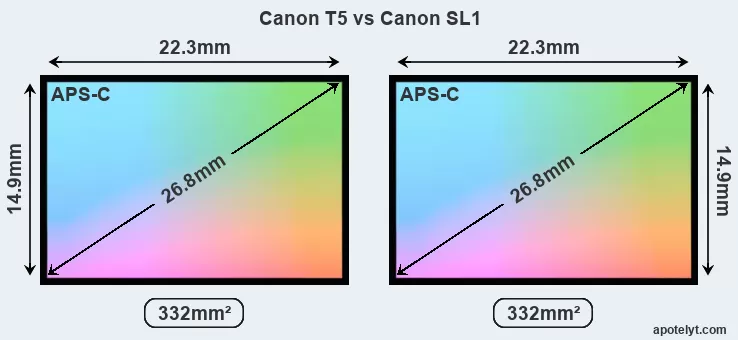
The two cameras under review do not only share the same sensor size, but also offer an identical resolution of 17.9 megapixels. This similarity in sensor specs implies that both the T5 and the SL1 have the same pixel density, as well as the same pixel size. It should, however, be noted that the T5 is a somewhat more recent model (by 10 months) than the SL1, and its sensor might have benefitted from technological advances during this time.
The SL1 has on-sensor phase detect pixels, which results in fast and reliable autofocus acquisition even during live view operation.
The Canon EOS Rebel T5 has a native sensitivity range from ISO 100 to ISO 6400, which can be extended to ISO 100-12800. The corresponding ISO settings for the Canon EOS Rebel SL1 are ISO 100 to ISO 12800, with the possibility to increase the ISO range to 100-25600.
Technology-wise, both cameras are equipped with CMOS (Complementary Metal–Oxide–Semiconductor) sensors. Both cameras use a Bayer filter for capturing RGB colors on a square grid of photosensors. This arrangement is found in most digital cameras.
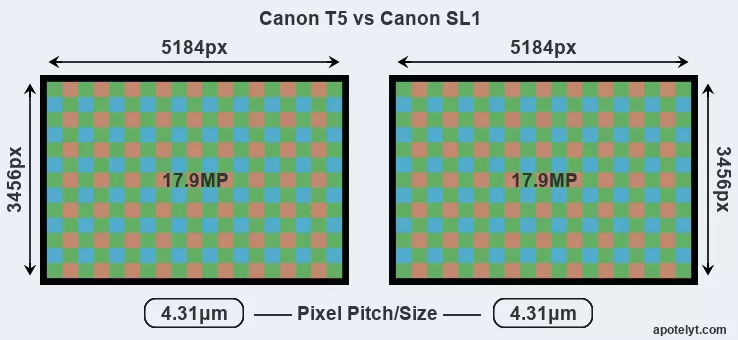
For many cameras, data on sensor performance has been reported by DXO Mark. This service is based on lab testing and assigns an overall score to each camera sensor, as well as ratings for dynamic range ("DXO Landscape"), color depth ("DXO Portrait"), and low-light sensitivity ("DXO Sports"). The Overall DXO ratings for the two cameras under consideration are close, suggesting that they provide similar imaging performance. The adjacent table reports on the physical sensor characteristics and the outcomes of the DXO sensor quality tests for a sample of comparator-cameras.

| Camera Model |
Sensor Class |
Resolution (MP) |
Horiz. Pixels |
Vert. Pixels |
Video Format |
DXO Portrait |
DXO Landscape |
DXO Sports |
DXO Overall |
||
|---|---|---|---|---|---|---|---|---|---|---|---|
| 1. | Canon T5 | APS-C | 17.9 | 5184 | 3456 | 1080/30p | 21.9 | 11.3 | 724 | 63 | |
| 2. | Canon SL1 | APS-C | 17.9 | 5184 | 3456 | 1080/30p | 21.8 | 11.3 | 843 | 63 | |
| 3. | Canon M | APS-C | 17.9 | 5184 | 3456 | 1080/30p | 22.1 | 11.2 | 827 | 65 | |
| 4. | Canon SL2 | APS-C | 24.0 | 6000 | 4000 | 1080/60p | 23.6 | 13.4 | 1041 | 79 | |
| 5. | Canon T2i | APS-C | 17.9 | 5184 | 3456 | 1080/30p | 22.1 | 11.5 | 784 | 66 | |
| 6. | Canon T3 | APS-C | 12.2 | 4272 | 2848 | 720/30p | 21.9 | 11.0 | 755 | 62 | |
| 7. | Canon T3i | APS-C | 17.9 | 5184 | 3456 | 1080/30p | 22.1 | 11.5 | 793 | 65 | |
| 8. | Canon T4i | APS-C | 17.9 | 5184 | 3456 | 1080/30p | 21.7 | 11.2 | 722 | 62 | |
| 9. | Canon T5i | APS-C | 17.9 | 5184 | 3456 | 1080/30p | 21.7 | 11.2 | 681 | 61 | |
| 10. | Canon T6 | APS-C | 17.9 | 5184 | 3456 | 1080/30p | 22.0 | 11.7 | 781 | 66 | |
| 11. | Canon T6i | APS-C | 24.0 | 6000 | 4000 | 1080/30p | 22.7 | 12.0 | 919 | 71 | |
| 12. | Canon T6s | APS-C | 24.0 | 6000 | 4000 | 1080/30p | 22.6 | 12.0 | 915 | 70 | |
| 13. | Canon T100 | APS-C | 17.9 | 5184 | 3456 | 1080/30p | 21.9 | 11.4 | 695 | 63 |
Many modern cameras are not only capable of taking still images, but can also record movies. The two cameras under consideration both have sensors whose read-out speed is fast enough to capture moving pictures, and both provide the same movie specifications (1080/30p).
Feature comparison
Beyond body and sensor, cameras can and do differ across a range of features. The T5 and the SL1 are similar in the sense that both have an optical viewfinder. The latter is useful for getting a clear image for framing even in brightly lit environments. The viewfinders of both cameras offer the same field of view (95%), but the viewfinder of the SL1 has a higher magnification than the one of the T5 (0.54x vs 0.50x), so that the size of the image transmitted appears closer to the size seen with the naked human eye. The adjacent table lists some of the other core features of the Canon T5 and Canon SL1 along with similar information for a selection of comparators.

| Camera Model |
Viewfinder (Type or 000 dots) |
Control Panel (yes/no) |
LCD Specifications (inch/000 dots) |
LCD Attach- ment |
Touch Screen (yes/no) |
Max Shutter Speed * |
Max Shutter Flaps * |
Built-in Flash (yes/no) |
Built-in Image Stab |
||
|---|---|---|---|---|---|---|---|---|---|---|---|
| 1. | Canon T5 | optical | n | 3.0 / 460 | fixed | n | 1/4000s | 3.0/s | Y | n | |
| 2. | Canon SL1 | optical | n | 3.0 / 1040 | fixed | Y | 1/4000s | 4.9/s | Y | n | |
| 3. | Canon M | none | n | 3.0 / 1040 | fixed | Y | 1/4000s | 4.3/s | n | n | |
| 4. | Canon SL2 | optical | n | 3.0 / 1040 | swivel | Y | 1/4000s | 5.0/s | Y | n | |
| 5. | Canon T2i | optical | n | 3.0 / 1040 | fixed | n | 1/4000s | 3.7/s | Y | n | |
| 6. | Canon T3 | optical | n | 2.7 / 230 | fixed | n | 1/4000s | 3.0/s | Y | n | |
| 7. | Canon T3i | optical | n | 3.0 / 1040 | swivel | n | 1/4000s | 3.7/s | Y | n | |
| 8. | Canon T4i | optical | n | 3.0 / 1040 | swivel | Y | 1/4000s | 5.0/s | Y | n | |
| 9. | Canon T5i | optical | n | 3.0 / 1040 | swivel | Y | 1/4000s | 5.0/s | Y | n | |
| 10. | Canon T6 | optical | n | 3.0 / 920 | fixed | n | 1/4000s | 3.0/s | Y | n | |
| 11. | Canon T6i | optical | n | 3.0 / 1040 | swivel | Y | 1/4000s | 5.0/s | Y | n | |
| 12. | Canon T6s | optical | Y | 3.0 / 1040 | swivel | Y | 1/4000s | 5.0/s | Y | n | |
| 13. | Canon T100 | optical | n | 2.7 / 230 | fixed | n | 1/4000s | 3.0/s | Y | n | |
| Note: *) Information refers to the mechanical shutter, unless the camera only has an electronic one. | |||||||||||
One differentiating feature between the two cameras concerns the touch sensitivity of the rear screen. The SL1 has a touchscreen, while the T5 has a conventional panel. Touch control can be particularly helpful, for example, for setting the focus point.
Concerning the storage of imaging data, both the T5 and the SL1 write their files to SDXC cards. The SL1 supports UHS-I cards (Ultra High Speed data transfer of up to 104 MB/s), while the T5 cannot take advantage of Ultra High Speed SD cards.
Connectivity comparison
For some imaging applications, the extent to which a camera can communicate with its environment can be an important aspect in the camera decision process. The table below provides an overview of the connectivity of the Canon EOS Rebel T5 and Canon EOS Rebel SL1 and, in particular, the interfaces the cameras (and selected comparators) provide for accessory control and data transfer.

| Camera Model |
Hotshoe Port |
Internal Mic / Speaker |
Microphone Port |
Headphone Port |
HDMI Port |
USB Port |
WiFi Support |
NFC Support |
Bluetooth Support |
||
|---|---|---|---|---|---|---|---|---|---|---|---|
| 1. | Canon T5 | Y | mono / mono | - | - | mini | 2.0 | - | - | - | |
| 2. | Canon SL1 | Y | mono / mono | Y | - | mini | 2.0 | - | - | - | |
| 3. | Canon M | Y | stereo / mono | Y | - | mini | 2.0 | - | - | - | |
| 4. | Canon SL2 | Y | stereo / mono | Y | - | mini | 2.0 | Y | Y | Y | |
| 5. | Canon T2i | Y | stereo / - | Y | - | mini | 2.0 | - | - | - | |
| 6. | Canon T3 | Y | stereo / mono | - | - | mini | 2.0 | - | - | - | |
| 7. | Canon T3i | Y | mono / mono | Y | - | mini | 2.0 | - | - | - | |
| 8. | Canon T4i | Y | stereo / mono | Y | - | mini | 2.0 | - | - | - | |
| 9. | Canon T5i | Y | stereo / mono | Y | - | mini | 2.0 | - | - | - | |
| 10. | Canon T6 | Y | mono / mono | - | - | mini | 2.0 | Y | Y | - | |
| 11. | Canon T6i | Y | stereo / mono | Y | - | mini | 2.0 | Y | Y | - | |
| 12. | Canon T6s | Y | stereo / mono | Y | - | mini | 2.0 | Y | Y | - | |
| 13. | Canon T100 | Y | mono / mono | - | - | mini | 2.0 | Y | Y | - |
It is notable that the SL1 has a microphone port, which can help to improve the quality of audio recordings by attaching an external microphone. The T5 does not feature such a mic input.
Both the T5 and the SL1 have been discontinued, but can regularly be found used on ebay. The SL1 was replaced by the Canon SL2, while the T5 was followed by the Canon T6. Further information on the features and operation of the T5 and SL1 can be found, respectively, in the Canon T5 Manual (free pdf) or the online Canon SL1 Manual.
Review summary
So what conclusions can be drawn? Is the Canon T5 better than the Canon SL1 or vice versa? The listing below highlights the relative strengths of the two models.
Arguments in favor of the Canon EOS Rebel T5:
- Longer lasting: Can take more shots (500 versus 380) on a single battery charge.
- More affordable: Was introduced into a lower priced segment (18 percent cheaper at launch).
- More modern: Is somewhat more recent (announced 10 months after the SL1).
Advantages of the Canon EOS Rebel SL1:
- Better jpgs: Has a more modern image processing engine (DIGIC 5 vs DIGIC 4).
- Better live-view autofocus: Features on-sensor phase-detection for more confident autofocus.
- Better sound: Can connect to an external microphone for higher quality sound recording.
- Larger viewfinder image: Features a viewfinder with a higher magnification (0.54x vs 0.50x).
- More detailed LCD: Has a higher resolution rear screen (1040k vs 460k dots).
- Fewer buttons to press: Has a touchscreen to facilitate handling and shooting adjustments.
- Faster burst: Shoots at higher frequency (4.9 vs 3 flaps/sec) to capture the decisive moment.
- More compact: Is smaller (117x91mm vs 130x100mm) and will fit more readily into a bag.
- Less heavy: Has a lower weight (by 73g or 15 percent) and is thus easier to take along.
- Faster buffer clearing: Has an SD card interface that supports the UHS-I standard.
- More heavily discounted: Has been on the market for longer (launched in March 2013).
If the count of relative strengths (bullet points above) is taken as a measure, the SL1 is the clear winner of the contest (11 : 3 points). However, the pertinence of the various camera strengths will differ across photographers, so that you might want to weigh individual camera traits according to their importance for your own imaging needs before making a camera decision. A professional wildlife photographer will view the differences between cameras in a way that diverges from the perspective of a family photog, and a person interested in architecture has distinct needs from a sports shooter. Hence, the decision which camera is best and worth buying is often a very personal one.
How about other alternatives? Do the specifications of the Canon T5 and the Canon SL1 place the cameras among the top in their class? Find out in the latest Best DSLR Camera listing whether the two cameras rank among the cream of the crop.
In any case, while the comparison of technical specifications can provide a useful overview of the capabilities of different cameras, it remains partial and cannot reveal, for example, the shooting experience and imaging performance when actually working with the T5 or the SL1. At times, user reviews, such as those published at amazon, address these issues in a useful manner, but such feedback is on many occasions incomplete, inconsistent, and unreliable.
Expert reviews
This is why expert reviews are important. The table below provides a synthesis of the camera assessments of some of the best known photo-gear review sites (amateurphotographer [AP], cameralabs [CL], digitalcameraworld [DCW], dpreview [DPR], ephotozine [EPZ], photographyblog [PB]). As can be seen, the professional reviewers agree in many cases on the quality of different cameras, but sometimes their assessments diverge, reinforcing the earlier point that a camera decision is often a very personal choice.

| Camera Model |
AP score |
CL score |
DCW score |
DPR score |
EPZ score |
PB score |
Camera Launch |
Launch Price (USD) |
Street Price |
||
|---|---|---|---|---|---|---|---|---|---|---|---|
| 1. | Canon T5 | 3/5 | + | .. | .. | 4/5 | 4.5/5 | Feb 2014 | 449 | ebay.com | |
| 2. | Canon SL1 | 4/5 | + | .. | 78/100 | 4/5 | 4/5 | Mar 2013 | 549 | ebay.com | |
| 3. | Canon M | 3/5 | + | .. | .. | 4/5 | 4/5 | Jul 2012 | 599 | ebay.com | |
| 4. | Canon SL2 | 4/5 | + + | 4/5 | 78/100 | 4.5/5 | 4.5/5 | Jun 2017 | 549 | ebay.com | |
| 5. | Canon T2i | .. | + + | .. | 77/100 | 4/5 | 4.5/5 | Feb 2010 | 699 | ebay.com | |
| 6. | Canon T3 | .. | 80/100 | .. | 69/100 | 4/5 | 4.5/5 | Feb 2011 | 449 | ebay.com | |
| 7. | Canon T3i | 3/5 | o | .. | 77/100 | 4.5/5 | 4.5/5 | Feb 2011 | 599 | ebay.com | |
| 8. | Canon T4i | 4/5 | + + | .. | 77/100 | 4.5/5 | 4.5/5 | Jun 2012 | 849 | ebay.com | |
| 9. | Canon T5i | .. | .. | .. | 76/100 | 4.5/5 | 4.5/5 | Mar 2013 | 649 | ebay.com | |
| 10. | Canon T6 | 4/5 | o | 4/5 | 73/100 | 4/5 | 4/5 | Mar 2016 | 449 | ebay.com | |
| 11. | Canon T6i | 5/5 | .. | .. | 75/100 | 4.5/5 | 4.5/5 | Feb 2015 | 749 | ebay.com | |
| 12. | Canon T6s | 5/5 | + | .. | 77/100 | 4.5/5 | 4.5/5 | Feb 2015 | 649 | ebay.com | |
| 13. | Canon T100 | .. | o | 3/5 | .. | 3.5/5 | 3.5/5 | Feb 2018 | 399 | amazon.com | |
| Note: (+ +) highly recommended; (+) recommended; (o) reviewed; (..) not available. | |||||||||||
The above review scores should be interpreted with care, though. The ratings were established in reference to similarly priced cameras that were available in the market at the time of the review. Thus, a score needs to be put into the context of the launch date and the launch price of the camera, and comparing ratings of very distinct cameras or ones that are far apart in terms of their release date have little meaning. It should also be noted that some of the review sites have over time altered the way they render their verdicts.

Check T5 offers at
ebay.com

Check SL1 offers at
ebay.com
Other camera comparisons
Did this review help to inform your camera decision process? In case you are interested in seeing how other cameras pair up, just make a corresponding selection in the search boxes below. There is also a set of direct links to comparison reviews that other users of the CAM-parator app explored.
Specifications: Canon T5 vs Canon SL1
Below is a side-by-side comparison of the specs of the two cameras to facilitate a quick review of their differences and common features.
| Camera Model | Canon T5 | Canon SL1 |
|---|---|---|
| Camera Type | Digital single lens reflex | Digital single lens reflex |
| Camera Lens | Canon EF mount lenses | Canon EF mount lenses |
| Launch Date | February 2014 | March 2013 |
| Launch Price | USD 449 | USD 549 |
| Sensor Specs | Canon T5 | Canon SL1 |
| Sensor Technology | CMOS | CMOS |
| Sensor Format | APS-C Sensor | APS-C Sensor |
| Sensor Size | 22.3 x 14.9 mm | 22.3 x 14.9 mm |
| Sensor Area | 332.27 mm2 | 332.27 mm2 |
| Sensor Diagonal | 26.8 mm | 26.8 mm |
| Crop Factor | 1.6x | 1.6x |
| Sensor Resolution | 17.9 Megapixels | 17.9 Megapixels |
| Image Resolution | 5184 x 3456 pixels | 5184 x 3456 pixels |
| Pixel Pitch | 4.31 μm | 4.31 μm |
| Pixel Density | 5.39 MP/cm2 | 5.39 MP/cm2 |
| Moiré control | Anti-Alias filter | Anti-Alias filter |
| Movie Capability | 1080/30p Video | 1080/30p Video |
| ISO Setting | 100 - 6,400 ISO | 100 - 12,800 ISO |
| ISO Boost | 100 - 12,800 ISO | 100 - 25,600 ISO |
| Image Processor | DIGIC 4 | DIGIC 5 |
| DXO Sensor Quality (score) | 63 | 63 |
| DXO Color Depth (bits) | 21.9 | 21.8 |
| DXO Dynamic Range (EV) | 11.3 | 11.3 |
| DXO Low Light (ISO) | 724 | 843 |
| Screen Specs | Canon T5 | Canon SL1 |
| Viewfinder Type | Optical viewfinder | Optical viewfinder |
| Viewfinder Field of View | 95% | 95% |
| Viewfinder Magnification | 0.50x | 0.54x |
| LCD Framing | Live View | Live View |
| Rear LCD Size | 3.0inch | 3.0inch |
| LCD Resolution | 460k dots | 1040k dots |
| LCD Attachment | Fixed screen | Fixed screen |
| Touch Input | no Touchscreen | Touchscreen |
| Shooting Specs | Canon T5 | Canon SL1 |
| Focus System | Phase-detect AF | Phase-detect AF |
| Continuous Shooting | 3 shutter flaps/s | 4.9 shutter flaps/s |
| Shutter Life Expectancy | 100 000 actuations | 100 000 actuations |
| Fill Flash | Built-in Flash | Built-in Flash |
| Storage Medium | SDXC cards | SDXC cards |
| Single or Dual Card Slots | Single card slot | Single card slot |
| UHS card support | no | UHS-I |
| Connectivity Specs | Canon T5 | Canon SL1 |
| External Flash | Hotshoe | Hotshoe |
| USB Connector | USB 2.0 | USB 2.0 |
| HDMI Port | mini HDMI | mini HDMI |
| Microphone Port | no MIC socket | External MIC port |
| Wifi Support | no Wifi | no Wifi |
| Body Specs | Canon T5 | Canon SL1 |
| Battery Type | Canon LP-E10 | Canon LP-E12 |
| Battery Life (CIPA) | 500 shots per charge | 380 shots per charge |
| Body Dimensions |
130 x 100 x 78 mm (5.1 x 3.9 x 3.1 in) |
117 x 91 x 69 mm (4.6 x 3.6 x 2.7 in) |
| Camera Weight | 480 g (16.9 oz) | 407 g (14.4 oz) |

Check T5 offers at
ebay.com

Check SL1 offers at
ebay.com
Did you notice an error on this page? If so, please get in touch, so that we can correct the information.

